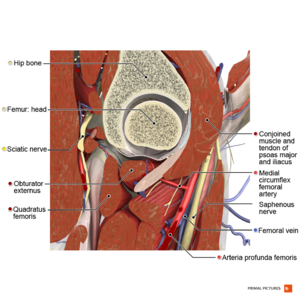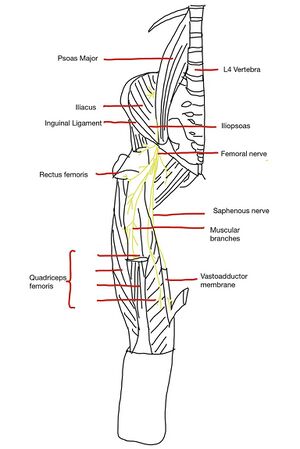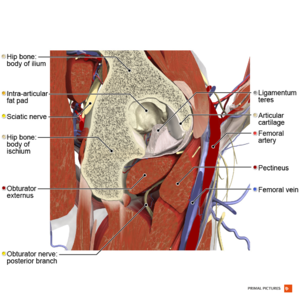Functional Anatomy of the Hip - Neural and Vascular: Difference between revisions
No edit summary |
(references edited) |
||
| Line 9: | Line 9: | ||
== Nerve Supply == | == Nerve Supply == | ||
Hilton's law states “The same trunks of nerves, whose branches supply the groups of muscles moving a joint, furnish also a distribution of nerves to the skin over the insertions of the same muscles; and – what at this moment more especially merits our attention – the interior of the joint receives its nerves from the same source.” <ref>[https://www.ncbi.nlm.nih.gov/pmc/articles/PMC2717375/ | Hilton's law states “The same trunks of nerves, whose branches supply the groups of muscles moving a joint, furnish also a distribution of nerves to the skin over the insertions of the same muscles; and – what at this moment more especially merits our attention – the interior of the joint receives its nerves from the same source.” <ref>Hilton J. [https://www.ncbi.nlm.nih.gov/pmc/articles/PMC2717375/pdf/11999_2009_Article_927.pdf The Classic: On Rest and Pain: Lecture XIV.] Clin Orthop Relat Res. 2009 Sep;467(9):2208-14. </ref>A joint tends to be innervated by a branch of a motor nerve which also supplies a muscle extending and acting across the joint, another branch of the nerve often supplies the overlying skin. | ||
* The [[Obturator Nerve|obturator nerve]] is considered the primary source of innervation to the hip. | * The [[Obturator Nerve|obturator nerve]] is considered the primary source of innervation to the hip. | ||
[[File:Femoral nerve and muscle innervations .jpeg|thumb|Femoral Nerve]] | [[File:Femoral nerve and muscle innervations .jpeg|thumb|Femoral Nerve]] | ||
* Branches of the [[Femoral Nerve|femoral]] and [[Sciatic Nerve|sciatic]] nerves contribute to its sensory innervation.<ref> | * Branches of the [[Femoral Nerve|femoral]] and [[Sciatic Nerve|sciatic]] nerves contribute to its sensory innervation.<ref>Thorp L.E. (2014) Hip Anatomy. In: Nho S., Leunig M., Kelly B., Bedi A., Larson C. (eds) Hip Arthroscopy and Hip Joint Preservation Surgery. Springer, New York, NY. </ref> | ||
* The hip joint receives multiple innervations primarily involving the hip capsule. | * The hip joint receives multiple innervations primarily involving the hip capsule. | ||
| Line 22: | Line 22: | ||
* The anteromedial and anteroinferior regions are supplied by the medial articular nerve, which arises from the anterior division of the obturator nerve. | * The anteromedial and anteroinferior regions are supplied by the medial articular nerve, which arises from the anterior division of the obturator nerve. | ||
* The ligamentum teres is innervated by the posterior branch of the obturator nerve .<ref>Robbins CE (1998) Anatomy and biomechanics, In: The Hip Handbook edited by Fagerson TL (Eds.); Boston, MA: Butterworth-Heinemann, p. 1-37.</ref> <ref>Harty M (1984) The anatomy of the hip joint. In: Surgery of the Hip Joint, (2nd edn); edited by Tronzo R, Springer-Verlag, New York, p. 49-74.</ref> | * The ligamentum teres is innervated by the posterior branch of the obturator nerve .<ref>Robbins CE (1998) Anatomy and biomechanics, In: The Hip Handbook edited by Fagerson TL (Eds.); Boston, MA: Butterworth-Heinemann, p. 1-37.</ref> <ref>Harty M (1984) The anatomy of the hip joint. In: Surgery of the Hip Joint, (2nd edn); edited by Tronzo R, Springer-Verlag, New York, p. 49-74.</ref> | ||
* Acetabular labrum consists of sensory nerve end organs and ramified free nerve endings, suggesting that the labrum may provide nociceptive and proprioceptive feedback to and from the hip joint <ref> | * Acetabular labrum consists of sensory nerve end organs and ramified free nerve endings, suggesting that the labrum may provide nociceptive and proprioceptive feedback to and from the hip joint <ref>Kim YT, Azuma H. The nerve endings of the acetabular labrum. Clin Orthop Relat Res. 1995 Nov;(320):176-81. </ref> | ||
[[File:Sagittal section of the structures of the hip 1 Primal.png|thumb|Femoral artery]] | [[File:Sagittal section of the structures of the hip 1 Primal.png|thumb|Femoral artery]] | ||
| Line 43: | Line 41: | ||
* Ascending branch of medial circumflex femoral artery | * Ascending branch of medial circumflex femoral artery | ||
* Ascending branch of lateral circumflex femoral artery | * Ascending branch of lateral circumflex femoral artery | ||
* Inferior gluteal artery<ref>[ | * Inferior gluteal artery<ref>Zaghloul A, Elalfy MM. [https://biomedres.us/pdfs/BJSTR.MS.ID.002267.pdf Hip Joint: Embryology, Anatomy and Biomechanics]. Biomed J Sci & Tech Res. 2018; 12(3). </ref><ref>Wininger AE, Barter LE, Boutris N, Pulido LF, Ellis TJ, Nho SJ, Harris JD. [https://academic.oup.com/jhps/article/7/2/183/5881579 Hip arthroscopy for lateral cam morphology: how important are the vessels?], Journal of Hip Preservation Surgery, 2020; 7 (2):183-194.</ref> | ||
== Clinical Importance == | == Clinical Importance == | ||
[[Avascular necrosis of the femoral head|Avascular necrosis]] of the hip is a condition characterized by the death of the femoral head due to disruption of its vascular supply, mainly by Medial Femoral Circumflex Artery. It leads to insidious onset of hip pain, usually with movement, and can be the result of a variety of factors. Some of the most common causes can be remembered by the mnemonic “ASEPTIC”: | [[Avascular necrosis of the femoral head|''Avascular necrosis'']] of the hip is a condition characterized by the death of the femoral head due to disruption of its vascular supply, mainly by Medial Femoral Circumflex Artery. It leads to insidious onset of hip pain, usually with movement, and can be the result of a variety of factors. Some of the most common causes can be remembered by the mnemonic “ASEPTIC”: | ||
* Alcohol/AIDS | * Alcohol/AIDS | ||
| Line 60: | Line 54: | ||
* Trauma | * Trauma | ||
* Idiopathic (Legg-Calve-Perthes disease), infection, iatrogenic | * Idiopathic (Legg-Calve-Perthes disease), infection, iatrogenic | ||
* Caisson disease<ref>[https://www.ncbi.nlm.nih.gov/books/NBK542174/# Anatomy, Abdomen and Pelvis, Hip Arteries] | * Caisson disease<ref>Jordan JA, Burns B. [https://www.ncbi.nlm.nih.gov/books/NBK542174/# Anatomy, Abdomen and Pelvis, Hip Arteries.] [Updated 2021 Jul 26]. In: StatPearls [Internet]. Treasure Island (FL): StatPearls Publishing; 2022 Jan-. Available from: <nowiki>https://www.ncbi.nlm.nih.gov/books/NBK542174/#</nowiki></ref> | ||
[https://www.ncbi.nlm.nih.gov/books/NBK542174/# | |||
{{#ev:youtube|Qe0MxGuZC78}}<ref>Avascular Necrosis, Blood Supply Femoral Head- Everything You Need To Know - Dr Nabil Ebraheim. Available from :https://www.youtube.com/watch?v=Qe0MxGuZC78</ref> | {{#ev:youtube|Qe0MxGuZC78}}<ref>Avascular Necrosis, Blood Supply Femoral Head- Everything You Need To Know - Dr Nabil Ebraheim. Available from :https://www.youtube.com/watch?v=Qe0MxGuZC78</ref> | ||
The neurologic injury usually is associated with traumatic dislocation and fracture-dislocation of the hip. The sciatic nerve, usually the peroneal branch, is most often injured, and this complication can be seen after all types of posterior fracture-dislocations and simple posterior dislocations. The [[Sciatic Nerve Injury|sciatic nerve]] can be acutely lacerated, stretched, or compressed, or later encased in heterotopic ossification. Neurologic examination at the time of injury often is difficult but is extremely important. Rehabilitation of patients with sciatic nerve injury must begin as early as possible and should focus on the prevention of an equinus foot deformity. <ref> | ''The neurologic injury'' usually is associated with traumatic dislocation and fracture-dislocation of the hip. The sciatic nerve, usually the peroneal branch, is most often injured, and this complication can be seen after all types of posterior fracture-dislocations and simple posterior dislocations. The [[Sciatic Nerve Injury|sciatic nerve]] can be acutely lacerated, stretched, or compressed, or later encased in heterotopic ossification. Neurologic examination at the time of injury often is difficult but is extremely important. Rehabilitation of patients with sciatic nerve injury must begin as early as possible and should focus on the prevention of an equinus foot deformity. <ref>Cornwall R, Radomisli TE. Nerve injury in traumatic dislocation of the hip. Clin Orthop Relat Res. 2000 Aug;(377):84-91.</ref> | ||
Intramuscular injection is one of the complications and the sciatic nerve is the most frequently affected nerve, especially in children, the elderly and underweight patients. The neurological presentation may range from minor transient pain to severe sensory disturbance and motor loss with poor recovery. Management of nerve injection injury includes drug treatment of pain, physiotherapy, use of assistive devices and surgical exploration. Early recognition of nerve injection injury and appropriate management is crucial in order to reduce the neurological deficit and maximize recovery. If the injection has to be administered into the gluteal muscle, the ventrogluteal region (gluteal triangle) has a more favourable safety profile than the dorsogluteal region (the upper outer quadrant of the buttock).<ref> | ''Intramuscular injection'' is one of the complications and the sciatic nerve is the most frequently affected nerve, especially in children, the elderly and underweight patients. The neurological presentation may range from minor transient pain to severe sensory disturbance and motor loss with poor recovery. Management of nerve injection injury includes drug treatment of pain, physiotherapy, use of assistive devices and surgical exploration. Early recognition of nerve injection injury and appropriate management is crucial in order to reduce the neurological deficit and maximize recovery. If the injection has to be administered into the gluteal muscle, the ventrogluteal region (gluteal triangle) has a more favourable safety profile than the dorsogluteal region (the upper outer quadrant of the buttock).<ref>Jung Kim H, Hyun Park S. Sciatic nerve injection injury. J Int Med Res. 2014 Aug;42(4):887-97. </ref> | ||
{{#ev:youtube|AxKEJQg6lB8}}<ref>Glute injection - Everything You Need To Know - Dr Nabil Ebraheim. Available from:https://www.youtube.com/watch?v=AxKEJQg6lB8</ref> | {{#ev:youtube|AxKEJQg6lB8}}<ref>Glute injection - Everything You Need To Know - Dr Nabil Ebraheim. Available from:https://www.youtube.com/watch?v=AxKEJQg6lB8</ref> | ||
== References == | == References == | ||
Revision as of 23:09, 3 March 2022
Original Editor - Rishika Babburu
Top Contributors - Rishika Babburu, Ewa Jaraczewska and Kim Jackson
Introduction[edit | edit source]
The hip joint is a synovial joint with articulation between the femoral head and the acetabulum of the pelvis. The rounded femoral head sits within the cup-shaped acetabulum of the pelvis.
Nerve Supply[edit | edit source]
Hilton's law states “The same trunks of nerves, whose branches supply the groups of muscles moving a joint, furnish also a distribution of nerves to the skin over the insertions of the same muscles; and – what at this moment more especially merits our attention – the interior of the joint receives its nerves from the same source.” [1]A joint tends to be innervated by a branch of a motor nerve which also supplies a muscle extending and acting across the joint, another branch of the nerve often supplies the overlying skin.
- The obturator nerve is considered the primary source of innervation to the hip.
- The hip joint receives multiple innervations primarily involving the hip capsule.
- The posterior articular nerve, a branch of the nerve to the quadratus femoris provides the most extensive nerve supply to the hip joint, including the posterior and inferior regions of the capsule and the ischiofemoral ligament.
- Superiorly, the hip capsule is innervated by the superior gluteal nerve.
- Anterior innervation of the capsule is provided by direct branches of the femoral nerve.
- The anteromedial and anteroinferior regions are supplied by the medial articular nerve, which arises from the anterior division of the obturator nerve.
- The ligamentum teres is innervated by the posterior branch of the obturator nerve .[3] [4]
- Acetabular labrum consists of sensory nerve end organs and ramified free nerve endings, suggesting that the labrum may provide nociceptive and proprioceptive feedback to and from the hip joint [5]
Arterial Supply[edit | edit source]
Arterial supply of the hip joint is by the cruciate and trochanteric anastomoses supply. A branch from the posterior branch of the obturator artery may also be present in the ligamentum teres.
Cruciate anastomosis
- Transverse branch of medial circumflex femoral artery
- Transverse branch of lateral circumflex femoral artery
- Ascending branch of first perforator artery from profunda femoris artery
- Descending branch of an inferior gluteal artery
- Obturator artery.
Trochanteric anastomosis
- Descending branch of a superior gluteal artery
- Ascending branch of medial circumflex femoral artery
- Ascending branch of lateral circumflex femoral artery
- Inferior gluteal artery[6][7]
Clinical Importance[edit | edit source]
Avascular necrosis of the hip is a condition characterized by the death of the femoral head due to disruption of its vascular supply, mainly by Medial Femoral Circumflex Artery. It leads to insidious onset of hip pain, usually with movement, and can be the result of a variety of factors. Some of the most common causes can be remembered by the mnemonic “ASEPTIC”:
- Alcohol/AIDS
- Steroids, sickle cell disease, SLE
- Erlenmeyer flask (Gaucher disease)
- Pancreatitis
- Trauma
- Idiopathic (Legg-Calve-Perthes disease), infection, iatrogenic
- Caisson disease[8]
The neurologic injury usually is associated with traumatic dislocation and fracture-dislocation of the hip. The sciatic nerve, usually the peroneal branch, is most often injured, and this complication can be seen after all types of posterior fracture-dislocations and simple posterior dislocations. The sciatic nerve can be acutely lacerated, stretched, or compressed, or later encased in heterotopic ossification. Neurologic examination at the time of injury often is difficult but is extremely important. Rehabilitation of patients with sciatic nerve injury must begin as early as possible and should focus on the prevention of an equinus foot deformity. [10]
Intramuscular injection is one of the complications and the sciatic nerve is the most frequently affected nerve, especially in children, the elderly and underweight patients. The neurological presentation may range from minor transient pain to severe sensory disturbance and motor loss with poor recovery. Management of nerve injection injury includes drug treatment of pain, physiotherapy, use of assistive devices and surgical exploration. Early recognition of nerve injection injury and appropriate management is crucial in order to reduce the neurological deficit and maximize recovery. If the injection has to be administered into the gluteal muscle, the ventrogluteal region (gluteal triangle) has a more favourable safety profile than the dorsogluteal region (the upper outer quadrant of the buttock).[11]
References[edit | edit source]
- ↑ Hilton J. The Classic: On Rest and Pain: Lecture XIV. Clin Orthop Relat Res. 2009 Sep;467(9):2208-14.
- ↑ Thorp L.E. (2014) Hip Anatomy. In: Nho S., Leunig M., Kelly B., Bedi A., Larson C. (eds) Hip Arthroscopy and Hip Joint Preservation Surgery. Springer, New York, NY.
- ↑ Robbins CE (1998) Anatomy and biomechanics, In: The Hip Handbook edited by Fagerson TL (Eds.); Boston, MA: Butterworth-Heinemann, p. 1-37.
- ↑ Harty M (1984) The anatomy of the hip joint. In: Surgery of the Hip Joint, (2nd edn); edited by Tronzo R, Springer-Verlag, New York, p. 49-74.
- ↑ Kim YT, Azuma H. The nerve endings of the acetabular labrum. Clin Orthop Relat Res. 1995 Nov;(320):176-81.
- ↑ Zaghloul A, Elalfy MM. Hip Joint: Embryology, Anatomy and Biomechanics. Biomed J Sci & Tech Res. 2018; 12(3).
- ↑ Wininger AE, Barter LE, Boutris N, Pulido LF, Ellis TJ, Nho SJ, Harris JD. Hip arthroscopy for lateral cam morphology: how important are the vessels?, Journal of Hip Preservation Surgery, 2020; 7 (2):183-194.
- ↑ Jordan JA, Burns B. Anatomy, Abdomen and Pelvis, Hip Arteries. [Updated 2021 Jul 26]. In: StatPearls [Internet]. Treasure Island (FL): StatPearls Publishing; 2022 Jan-. Available from: https://www.ncbi.nlm.nih.gov/books/NBK542174/#
- ↑ Avascular Necrosis, Blood Supply Femoral Head- Everything You Need To Know - Dr Nabil Ebraheim. Available from :https://www.youtube.com/watch?v=Qe0MxGuZC78
- ↑ Cornwall R, Radomisli TE. Nerve injury in traumatic dislocation of the hip. Clin Orthop Relat Res. 2000 Aug;(377):84-91.
- ↑ Jung Kim H, Hyun Park S. Sciatic nerve injection injury. J Int Med Res. 2014 Aug;42(4):887-97.
- ↑ Glute injection - Everything You Need To Know - Dr Nabil Ebraheim. Available from:https://www.youtube.com/watch?v=AxKEJQg6lB8









